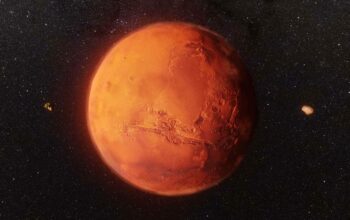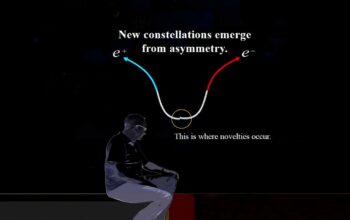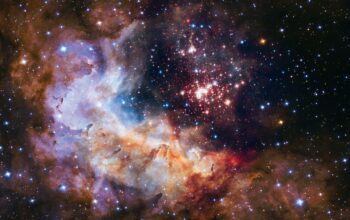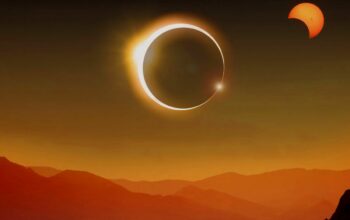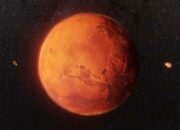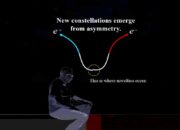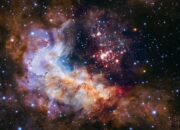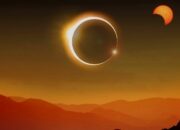In the grand tapestry of the cosmos, one might muse: do celestial bodies, particularly massive stars, possess an insatiable appetite for the interstellar medium, specifically cosmic dust? This inquiry opens an exploration of the mechanisms through which gigantic stars form, evolve, and subsequently impact their surrounding environments. The relationship between massive stars and cosmic dust is nuanced and multifaceted, presenting a compelling case for understanding stellar dynamics and galactic evolution.
Cosmic dust, primarily composed of silicates, carbonaceous materials, and ices, constitutes a fundamental component of the interstellar medium (ISM). It plays a pivotal role in star formation processes, providing the necessary material from which stars are birthed. When one speaks of massive stars, generally defined as those exceeding eight solar masses, the discussion inevitably includes their birth, lifecycle, and the implications of their existence on the galactic scale. These stellar titans are born from the gravitational collapse of dense regions within molecular clouds, where cosmic dust particles coalesce, paving the way for protostellar formation.
Intriguingly, what occurs during this formative phase is of immense significance. As these massive stars develop, they exhibit vigorous stellar winds and intense radiation pressures that can affect how nearby dust is gathered and recycled. The accretion process, fueled by the gravitational attraction of the forming star, leads to the ingestion of surrounding cosmic dust. This phenomenon poses a playful question: to what extent do these behemoths of the universe manipulate their environment, and can we discern a relationship that resembles a predatory feeding frenzy?
Once in a mature state, these massive stars engage in nuclear fusion processes, transforming hydrogen into helium and subsequently heavier elements. The energy output during this phase is formidable, creating a luminous body that illuminates vast swathes of the surrounding ISM. Furthermore, the stellar winds emanating from such stars eject vast quantities of material into the surrounding space, enriched with newly synthesized elements. This ejecta, while serving as a significant source of cosmic dust, further demonstrates the competitive nature of massive stars within their galactic neighborhoods.
Yet, the question remains: does this dynamic interplay signify a feeding frenzy, or is it indicative of an ecological balance within star formation? The term “feeding frenzy” suggests an uncontrolled consumption, a chaotic event where massive stars voraciously monopolize cosmic dust. In stark contrast, one could argue that this interaction is reflective of an intricate equilibrium, where dust serves both as sustenance for stellar growth and as a material reservoir for future generations of stars.
This interplay reaches a zenith during the life cycle of massive stars. After exhausting their nuclear fuel, they can no longer counteract gravitational forces, leading to a dramatic collapse. This implosion can culminate in a supernova event, which disperses dust and enriched stellar debris back into the ISM. Herein lies a challenge: while massive stars contribute to the galactic abundance of cosmic dust, they also create conditions where new stars can emerge. The cycle of death and rebirth lends itself to a profound ecological concept within astronomical contexts.
However, one must confront the broader implications of this cosmic phenomenon. The recycling of material via supernovae could be hypothesized to affect galactic evolution. The ejection of enriched dust may catalyze star formation in adjacent molecular clouds, thus propagating the cycle of stellar genesis. Discerning whether the behavior of massive stars represents an ecological feeding frenzy warrants further investigation into the feedback mechanisms within the ISM. How do these titanic events orchestrate the lifecycle of a galaxy?
Moreover, the distribution and composition of cosmic dust resulting from supernovae can foster or hinder the formation of new stars. It raises the question of whether massive stars are the benefactors or detractors in the grand cycle of star formation and galactic evolution. Calculating the precise influences of stellar winds and supernova ejecta on the ISM, and subsequently on new star formation, presents both theoretical and observational challenges.
Recent studies utilizing advanced observational techniques and simulations yield insight into these interactions, yet they remain rife with complexity and ambiguity. The challenge lies in quantitatively assessing the net effects of massive stars on cosmic dust distribution, while disentangling the roles played by other galactic phenomena, such as smaller stars and active galactic nuclei.
In addition to their influence on dust dynamics, massive stars have broader implications for their home galaxies. Such stars often exist in clusters, exhibiting collective behaviors that can significantly impact star formation rates across their locales. As they exert gravitational forces and emit energetic radiation, they sculpt the immediate ISM, thereby playing a crucial role in the larger galactic architecture. This collective influence potentially exacerbates or alleviates the “feeding frenzy” dynamic.
The relationship between cosmic dust and massive stars ultimately culminates in a labyrinthine interplay that transcends the simplistic notion of consumption. While applying the metaphor of a feeding frenzy can evoke images of voracious entities clamoring for resources, the reality is a sophisticated balance of creation and destruction, a dance that has endured across cosmic time frames. Hence, further exploration of these stellar entities and their behaviors will be required to develop a comprehensive understanding of their role in shaping not just star systems, but the very fabric of galaxies themselves.
In conclusion, as we ponder the dynamic interactions between massive stars and cosmic dust, it is essential to frame our understanding within a broader astrophysical context. The elegant dichotomy of creation and destruction, the feeding frenzy versus the ecological balance, drives inquiries that challenge existing paradigms and invite deeper scrutiny into the very nature of our universe.

